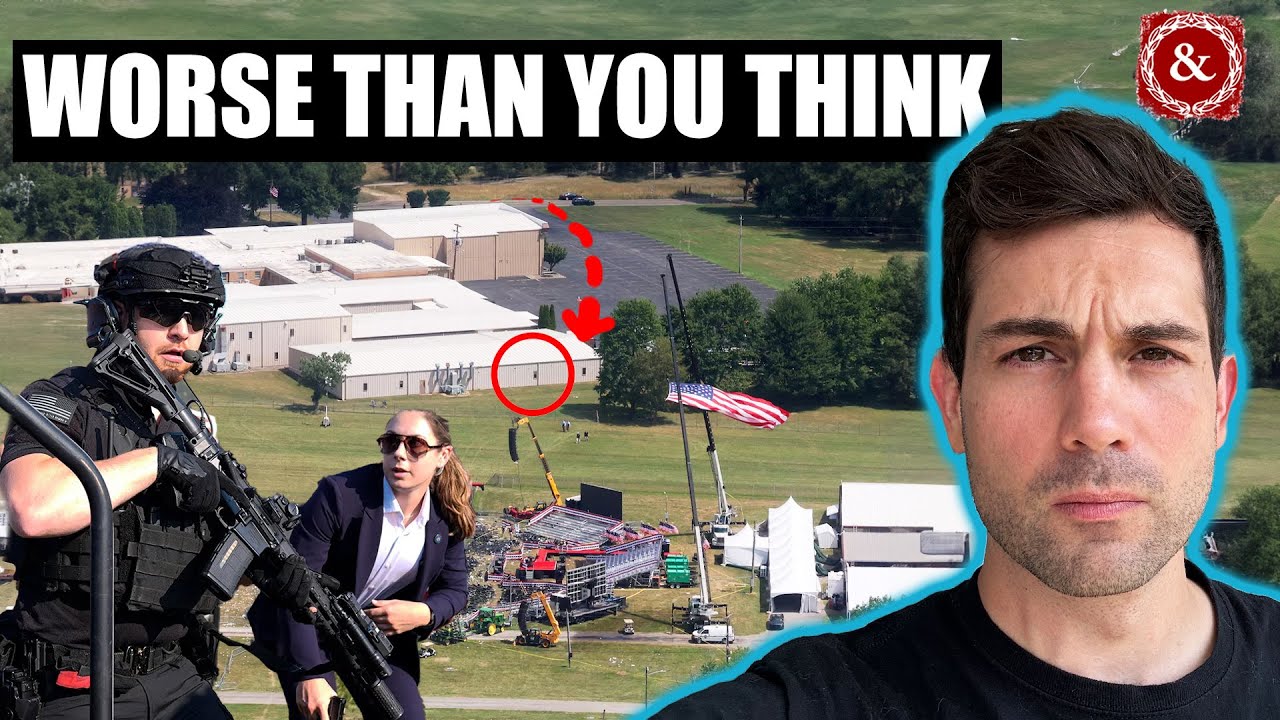The recent assassination attempt on former President Trump in Butler, Pennsylvania has exposed significant vulnerabilities within the Secret Service’s security protocols. The incident, involving a 20-year-old assailant who managed to get within a dangerously close distance of Trump and fire multiple shots, raises critical questions about the effectiveness of security measures that were presumably in place. Key failures include the inability to track a suspicious individual noted by local law enforcement, along with a clear breach of the perimeter at the AGR building without apprehension.
This analysis will explore the implications of the security lapses observed during the event, including the inadequate pre-planning that failed to secure access points to rooftops and the poor responses from law enforcement during the shooting. Criticism has mounted against the leadership of the Secret Service, with many calling for accountability for the lapses that allowed such a grave security breach to occur. Discussions around the future of operational protocols and rules of engagement for officers are expected to arise as investigations continue into both the shooter’s motives and the agency’s shortcomings.
Overview of the Assassination Attempt
Details of the Butler, PA Incident
On an otherwise unremarkable day in Butler, Pennsylvania, a shocking event unfolded that left a significant mark on national security protocols. In close proximity to a rally held by former President Donald Trump, a 20-year-old assailant managed to breach security measures and access a rooftop within dangerously close range—approximately 150 meters—from the speaker. The chaotic scene escalated rapidly when the assailant opened fire, resulting in a hail of gunfire that reverberated through the assembled crowd, sending attendees into a panic. This significant incident not only raised concerns about the immediate safety of public gatherings but also ignited a broader discussion regarding the responsibilities of law enforcement and security forces tasked with protecting high-profile individuals.
Immediate Outcomes and Impact
The immediate aftermath of the assassination attempt was one of confusion and alarm. As shots rang out, the crowd, initially there to express political support, was thrust into chaos. Law enforcement acted swiftly to contain the situation, but the implications of the event extended far beyond the immediate response. The threat posed by the assailant was significant, and the repercussions of the breach highlighted vulnerabilities in the existing security arrangements. This incident, which should have served as a safeguard for high-profile political figures, instead illuminated glaring deficiencies in pre-event planning and real-time threat assessment, raising questions about the efficacy of the security protocols in place.
Response from Law Enforcement
The response from law enforcement was commendably rapid, with both local police and Secret Service agents quickly mobilizing to neutralize the threat. However, as time unfolded, it became apparent that systemic issues marred their effectiveness. Reports indicated that while officers did engage the assailant on the rooftop, significant challenges hampered their actions. Concerns were raised regarding rules of engagement, leading to discussions about the adequacy of existing protocols and the need for revision. Overall, the incident catalyzed conversations on the intersection of law enforcement, political security, and the need for conscientious accountability.
Security Flaws of the Secret Service
Overview of Security Measures in Place
The Secret Service plays a crucial role in the protection of high-profile individuals, specifically presidents and their families. As part of this mandate, the agency employs a variety of advanced security measures, including perimeter surveillance, access control measures, and on-site personnel to ensure the safety of events. In Butler, PA, the Secret Service was tasked with establishing a secure environment for the rally, working in conjunction with local police. However, the events that transpired illustrated that despite the high costs associated with security, seminal flaws were embedded within the very framework designed to protect lives.
Identification of Key Vulnerabilities
In the aftermath of the Butler incident, a myriad of vulnerabilities was unearthed. Notably, the inability to track a suspicious individual, who was ultimately the assailant, was a glaring flaw in the security system. Officers initially observed the suspect holding a rangefinder—a device that could be used to gauge distance—yet lost sight of him amidst the bustling crowd. This lapse in vigilance underscores the need for a more robust surveillance strategy and reinforces the argument that security measures must evolve in tandem with emerging threats. Reports also indicated that critical access points, such as doors leading to the rooftop, were inadequately secured, further compounding the risks associated with the event.
Public Perception of Security Failures
Public perception following the assassination attempt was one of outrage and frustration. Citizens expressed dismay over the apparent shortcomings of the Secret Service, leading to calls for accountability at the highest levels. Many felt that the agency’s lack of preparedness not only endangered the former President but also placed the lives of numerous individuals in jeopardy. The repeated failures in security have prompted questions about the effectiveness of the agency and the broader implications for public trust in those tasked with safeguarding the nation’s leaders.
Profile of the Assailant

Background of the 20-year-old Shooter
The profile of the assailant serves as a sobering reminder of the complexities that underlie such acts of violence. The 20-year-old shooter, whose identity has sparked interest among investigators and the public alike, embodies the increasingly difficult challenge of identifying potential threats. Reports suggest that the individual was previously unknown to law enforcement, raising questions about the effectiveness of existing monitoring and intelligence-gathering mechanisms.
Motivations Behind the Attack
Understanding the motivations behind the attack is critical for both security analysts and policymakers alike. While investigations into the assailant’s background are ongoing, preliminary findings suggest a combination of personal grievances and ideological influences may have fueled this violent act. The motivations of such individuals often stem from a complex interplay of socio-political factors, underscoring the need for comprehensive preventative measures that address not just physical security, but also ideological extremities that lead individuals to resort to violence.
Assessment of the Shooter’s Planning and Execution
The successful execution of the assault points to a level of forethought and planning that demands scrutiny. The assailant’s ability to assess and navigate the security perimeter indicated a degree of awareness of the surveillance strategies in place. His choice to utilize a rooftop for the attack suggests a calculated approach, prompting further questions regarding how similar acts can be deterred in the future.
Breach of the Security Perimeter
Analysis of the Entry Point to the Rooftop
Upon examination, the breach of the security perimeter is alarming—it revealed critical weaknesses in security architecture. The access point to the rooftop was poorly monitored, allowing the shooter to ascend to an elevated position with relative ease. The analyzing of this breach not only requires a critical view of existing surveillance but compels a re-evaluation of how venues hosting high-stakes events are managed in terms of physical security and human oversight.
Coordination Between Local Police and Secret Service
The incident also highlights the critical need for coordination among law enforcement entities. Though local police and the Secret Service operated in tandem during the event, the failure to maintain effective communication and a unified command structure was conspicuous. The apparent lapse in collaboration exemplifies the challenges faced by security agencies when tasked with executing comprehensive safety measures in dynamic environments.
Failure to Monitor Suspicious Individuals
The spotlight on the failure to monitor suspicious individuals reveals a fundamental gap in law enforcement capabilities. Despite receiving reports of the shooter’s peculiar behavior prior to the attack, local police were unable to apprehend him before he could pose a significant threat. This oversight speaks to a larger issue within police protocols regarding identification and assessment of potential risks—showcasing a critical juncture that necessitates enhanced training and strategic implementation.
Pre-event Security Measures

Assessment of Planning and Preparation
The planning and preparation undertaken by the Secret Service and local law enforcement prior to the event fell short of adequate standards. Initial assessments failed to anticipate the myriad ways that an individual might exploit weaknesses within the perimeter. The lack of thorough risk assessments underscores the necessity for a comprehensive overhaul in security planning, focusing on predictive analysis that encompasses potential vulnerabilities unseen at the onset.
Evaluation of Door Lock and Rooftop Access Procedures
Critical evaluations of the procedures regarding door locks and rooftop access revealed systemic inadequacies. The shooter’s ability to maneuver onto the rooftop speaks volumes about the effectiveness of predetermined protocols that should have restricted access. Moving forward, a more stringent assessment of access control is paramount for future engagements—to ensure that loopholes are effectively eradicated.
Impact of Staffing Levels on Security Effectiveness
Staffing levels during the rally also came under scrutiny. Reports indicate that the presence of adequate personnel could have aided in the monitoring of potential threats, thus preventing the breach that occurred. The correlation between staffing levels and security effectiveness is evident—demonstrating that a well-resourced operation can significantly enhance situational awareness and threat response.
Witness Accounts and Reactions
Observation of the Shooter by Attendees
Witness accounts played a vital role in detailing the events leading up to the shooting. Several attendees reported having spotted the shooter prior to the incident, alerting law enforcement of his presence on the rooftop. Such firsthand narratives highlight the importance of situational awareness among the public during high-profile events, serving as a testament to the potential for civilian vigilance to act as a supplementary layer of security.
Attempts to Alert Law Enforcement
The proactive efforts of attendees to alert law enforcement reflect both an instinctual response to imminent danger and an understanding of communal responsibility. While some witnesses acted heroically in trying to mitigate the threat, the efficacy of their actions ultimately hinged upon the responsiveness of law enforcement, highlighting critical flaws in the operational structure during the crisis.
Emotional Responses from the Public and Officials
The emotional responses generated by the incident reveal the profound impact such acts of violence have on public sentiment. Fear, anger, and disbelief reverberated through social media and news channels, illuminating the pervasive anxiety that surrounds public gatherings and the safety of political figures. Officials and the broader community called for a reevaluation of security measures, underscoring the inherent need for a collective focus on safety and accountability.
Government and Congressional Response

Calls for Resignation of Secret Service Leadership
In the wake of the shooting, calls for the resignation of high-ranking officials within the Secret Service intensified, as public outrage over perceived security failures mounted. Critics argued that the leadership must take responsibility for the lapses in security that led to the assassination attempt, advocating for a swift and comprehensive response to restore public confidence.
Expected Congressional Hearings and Inquiries
In light of the incident, congressional hearings and inquiries are anticipated to scrutinize the actions and protocols of the Secret Service. Stakeholders seek reassurance that accountability measures will be enacted to avert similar crises in the future. The potential for disclosures during these inquiries could lead to substantial reforms, shaping policy regarding the protective measures entrusted to security agencies.
Comparative Analysis with Previous Security Failures
Comparative analyses of this incident with prior security failures add depth to the discourse regarding governmental accountability. Implicit in such discussions is the recognition of systemic errors, which compound when coupled with organizational inertia. Similar events in history serve as cautionary tales, reinforcing the necessity for adaptability and vigilance within security frameworks.
Law Enforcement’s Actions During the Incident
Engagement Rules for Local Officers
Local officers faced significant challenges dictated by existing engagement rules during the assassination attempt. The policies governing their interactions with potential threats created a complex landscape where officers were expressly prohibited from taking actions unless they identified unmistakable signs of an imminent threat—highlighting the need for a critical reevaluation of engagement protocols in situations marked by uncertainty.
Deployment of Counter Sniper Teams
Reports indicate that multiple counter sniper teams were deployed during the event; however, the specifics surrounding their engagement with the shooter remain murky. The effectiveness of these teams could potentially be scrutinized given the circumstances, raising questions about their operational protocols and decision-making frameworks in pressure situations.
Challenges Faced During the Response
The response to the incident was fraught with challenges that further complicated the unfolding drama. Officers’ decision-making capabilities were stymied not only by rules of engagement but by the sheer chaos of the situation unfolding before them. The multifaceted nature of the incident underscores the complex interplay between training and real-world application, positing a diligent need for enhanced preparedness.
Analysis of the Incident’s Security Performance
Critique of Advance Preparation and Threat Response
A critical analysis reveals that both advance preparation and the threat response during the Butler incident suffered from significant shortcomings. The failure to identify and mitigate potential risks prior to the rally illuminated a glaring deficiency in preemptive measures. As the incident transpired, the apparent disarray in immediate threat response painted an unsettling picture of security effectiveness—a narrative that demands exploration and rectification.
Assessment of Real-Time Decision-Making
Real-time decision-making proved to be a pivotal aspect of law enforcement’s response. Officers operating under stress encountered complex dilemmas with limited clarity, facing innate challenges in threat assessment. An analysis of their decision-making processes during the attempt could yield key lessons for improving crisis management protocols in the future.
Identifying Lessons for Future Security Operations
A reflective approach necessitates the identification of lessons learned from the Butler incident. Emphasizing both preventative measures and responsive strategies can contribute to a more comprehensive understanding of security operations. As agencies work to refine existing systems, the integration of best practices could bolster preparedness and adaptiveness in facing future threats.
Conclusion
Summary of Key Points
The Butler, PA assassination attempt underscores critical failures in security protocols designed to protect public figures. The incident illuminates vulnerabilities within the Secret Service and local law enforcement, raising pressing questions about preparedness, monitoring, and accountability. Witness accounts and government responses indicate a broad consensus on the need for immediate reforms to better safeguard future public gatherings.
The Importance of Accountability in Law Enforcement
Accountability remains paramount in the aftermath of the incident. As scrutiny increases regarding the actions of law enforcement and security agencies, the imperative for transparent evaluations cannot be overstated. Only through collective responsibility can the lapses in safety be addressed, restoring public confidence in the mechanisms that safeguard our most prominent leaders.
Reflection on the Impact of This Incident on Public Trust
The impact of the Butler incident ripples through the collective consciousness of the public; trust in security agencies has been strained as citizens grapple with fears regarding safety in an increasingly volatile landscape. The discussions surrounding the failings present opportunities for transformation and reform, but only if stakeholders prioritize transparency, adaptability, and vigilance in their efforts moving forward. Societal confidence in law enforcement hinges upon a recommitment to safeguard not only individuals but the very foundations of democratic process and American political life.
